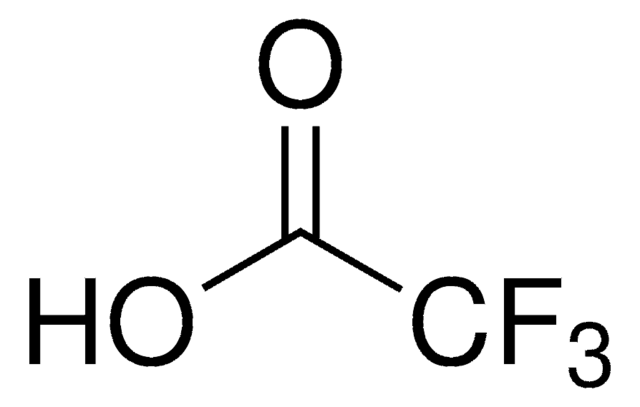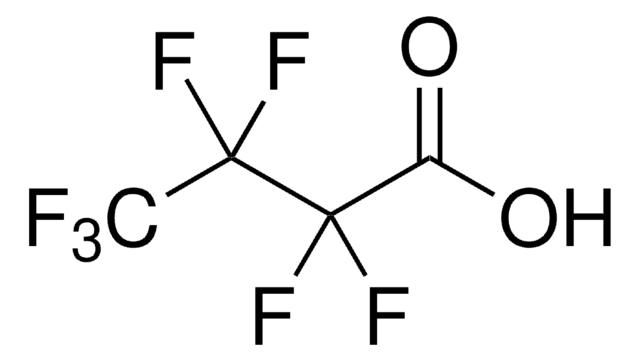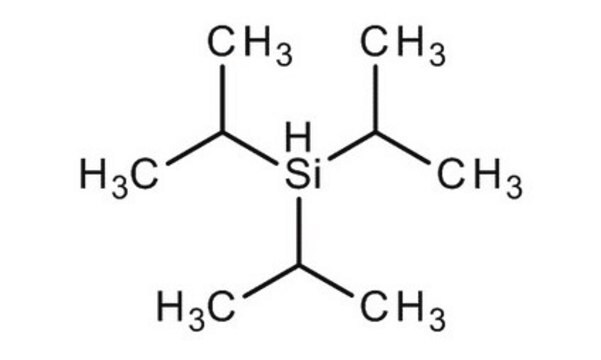8.08260
Trifluoroacetic acid
for synthesis
Synonym(s):
TFA
About This Item
Recommended Products
vapor density
3.9 (vs air)
Quality Level
vapor pressure
97.5 mmHg ( 20 °C)
Assay
≥99% (acidimetric)
form
liquid
refractive index
n20/D 1.3 (lit.)
pH
1 (10 g/L in H2O)
bp
72.4 °C (lit.)
mp
−15.4 °C (lit.)
solubility
soluble 10 g/mL
density
1.489 g/mL at 20 °C (lit.)
storage temp.
2-30°C
SMILES string
OC(C(F)(F)F)=O
InChI
1S/C2HF3O2/c3-2(4,5)1(6)7/h(H,6,7)
InChI key
DTQVDTLACAAQTR-UHFFFAOYSA-N
Looking for similar products? Visit Product Comparison Guide
General description
Application
- In the direct conversion of cyclohexanone to caprolactam using acetonitrile as the additive.
- In the synthesis of 1,2,4,5-tetrasubstituted imidazoles by four-component condensation of benzil, aldehydes, amines, and ammonium acetate.
- In the synthesis of d-α-Tterpineo from d-limonene by Markovnikov addition followed by hydrolysis.
Features and Benefits
- High acidity
- Easy elimination
- Good solubility in organic solvent and in water.
Analysis Note
Density (d 20 °C/ 4 °C): 1.487 - 1.490
Identity (IR): passes test
Signal Word
Danger
Hazard Statements
Precautionary Statements
Hazard Classifications
Acute Tox. 4 Inhalation - Aquatic Chronic 3 - Eye Dam. 1 - Skin Corr. 1A
Storage Class Code
8A - Combustible corrosive hazardous materials
WGK
WGK 2
Flash Point(F)
>212.0 °F - Pensky-Martens closed cup
Flash Point(C)
> 100 °C - Pensky-Martens closed cup
Regulatory Listings
Regulatory Listings are mainly provided for chemical products. Only limited information can be provided here for non-chemical products. No entry means none of the components are listed. It is the user’s obligation to ensure the safe and legal use of the product.
ISHL Indicated Name
Substances Subject to be Indicated Names
ISHL Notified Names
Substances Subject to be Notified Names
JAN Code
8082609999:
8082600521:
IN2RCMT808260:
8082602501:
8082600121:
8082600025:
8082609060:
8082600500:
IN28082600100:
8082600101:
8082600501:
8082600026:
8082601000:
IN28082600500:
8082601001:
8082602500:
8082609025:
IN28082602500:
8082600000:
8082600100:
8082609015:
Certificates of Analysis (COA)
Search for Certificates of Analysis (COA) by entering the products Lot/Batch Number. Lot and Batch Numbers can be found on a product’s label following the words ‘Lot’ or ‘Batch’.
Already Own This Product?
Find documentation for the products that you have recently purchased in the Document Library.
Customers Also Viewed
Related Content
Fmoc resin cleavage and deprotection follows the difficult task of detaching the peptide from the resin support and removing all the side-chain protecting groups of the amino acid residues to yield the desired peptide.
Our team of scientists has experience in all areas of research including Life Science, Material Science, Chemical Synthesis, Chromatography, Analytical and many others.
Contact Technical Service






